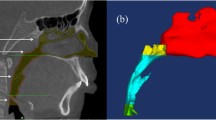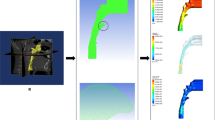Abstract
The possible negative outcomes of mandibular setback surgery (MSS) on the upper airway (UA) have become an important issue in recent years. The purpose of the present study was to compare the different amounts of MSS and to confirm the accepted maximum amount of mandibular setback by using Computational Fluid Dynamics (CFD) method. An anatomically similar UA model was constructed from magnetic resonance images of a systemically healthy individual. Two out of six models were kept as control models and the remaining four models were created to represent MSS scenarios with different amounts to correct Class III skeletal abnormality. The airflow was assumed laminar, incompressible, and the surrounding soft tissue was assumed to be linear elastic. The sixth model that was representative of 15 mm of MSS showed statistically significant differences from the other models (p < 0.05). No significant differences were observed among other models in terms of all the parameters (p > 0.05). CFD has been recently used in researches by modeling the UA flow; however, to the best of our knowledge, none of the studies have proved the maximum limits of MSS amounts with this technique.

ᅟ

Similar content being viewed by others
References
Demetriades N, Chang DJ, Laskarides C, Papageorge M (2010) Effects of mandibular retropositioning, with or without maxillary advancement, on the oro-naso-pharyngeal airway and development of sleep-related breathing disorders. J Oral Maxillofac Surg 68:2431–2436
Riley RW, Powell NB, Guilleminault C, Ware W (1987) Obstructive sleep apnea syndrome following surgery for mandibular prognathism. J Oral Maxillofac Surg 45:450–452
Huang R, Li X, Rong Q (2013) Control mechanism for the upper airway collapse in patients with obstructive sleep apnea syndrome: a finite element study. Sci China Life Sci 56:366–372
Kitagawara K, Kobayashi T, Goto H, Yokobayashi T, Kitamura N, Saito C (2008) Effects of mandibular setback surgery on oropharyngeal airway and arterial oxygen saturation. Int J Oral Maxillofac Surg 37:328–333
Radhakrishnan H, Kassinos S (2009) CFD modeling of turbulent flow and particle deposition in human lungs. Conf Proc IEEE Eng Med Biol Soc 2009:2867–2870
Yu CC, Hsiao HD, Tseng TI, Lee LC, Yao CM, Chen NH et al (2012) Computational fluid dynamics study of the inspiratory upper airway and clinical severity of obstructive sleep apnea. J Craniofac Surg 23:401–405
Jeong SJ, Kim WS, Sung SJ (2007) Numerical investigation on the flow characteristics and aerodynamic force of the upper airway of patient with obstructive sleep apnea using computational fluid dynamics. Med Eng Phys 29:637–651
Degerliyurt K, Ueki K, Hashiba Y, Marukawa K, Nakagawa K, Yamamoto E (2008) A comparative CT evaluation of pharyngeal airway changes in class III patients receiving bimaxillary surgery or mandibular setback surgery. Oral Surg Oral Med Oral Pathol Oral Radiol Endod 105:495–502
Hong JS, Park YH, Kim YJ, Hong SM, Oh KM (2011) Three-dimensional changes in pharyngeal airway in skeletal class III patients undergoing orthognathic surgery. J Oral Maxillofac Surg 69:e401–e408
Uesugi T, Kobayashi T, Hasebe D, Tanaka R, Ike M, Saito C (2014) Effects of orthognathic surgery on pharyngeal airway and respiratory function during sleep in patients with mandibular prognathism. Int J Oral Maxillofac Surg 43:1082–1090
Chen F, Terada K, Hua Y, Saito I (2007) Effects of bimaxillary surgery and mandibular setback surgery on pharyngeal airway measurements in patients with class III skeletal deformities. Am J Orthod Dentofac Orthop 131:372–377
Jakobsone G, Stenvik A, Espeland L (2011) The effect of maxillary advancement and impaction on the upper airway after bimaxillary surgery to correct class III malocclusion. Am J Orthod Dentofac Orthop 139:e369–e376
Muto T, Takeda S, Kanazawa M, Yamazaki A, Fujiwara Y, Mizoguchi I (2002) The effect of head posture on the pharyngeal airway space (PAS). Int J Oral Maxillofac Surg 31:579–583
Kawamata A, Fujishita M, Ariji Y, Ariji E (2000) Three-dimensional computed tomographic evaluation of morphologic airway changes after mandibular setback osteotomy for prognathism. Oral Surg Oral Med Oral Pathol Oral Radiol Endod 89:278–287
Jakobsone G, Neimane L, Krumina G (2010) Two- and three-dimensional evaluation of the upper airway after bimaxillary correction of class III malocclusion. Oral Surg Oral Med Oral Pathol Oral Radiol Endod 110:234–242
Lye KW (2008) Effect of orthognathic surgery on the posterior airway space (PAS). Ann Acad Med Singap 37:677–682
Partinen M, Guilleminault C, Quera-Salva MA, Jamieson A (1988) Obstructive sleep apnea and cephalometric roentgenograms. the role of anatomic upper airway abnormalities in the definition of abnormal breathing during sleep. Chest 93:1199–1205
Zhao M, Barber T, Cistulli PA, Sutherland K, Rosengarten G (2013) Simulation of upper airway occlusion without and with mandibular advancement in obstructive sleep apnea using fluid-structure interaction. J Biomech 46:2586–2592
Cheng S, Gandevia SC, Green M, Sinkus R, Bilston LE (2011) Viscoelastic properties of the tongue and soft palate using MR elastography. J Biomech 44:450–454
Hasebe D, Kobayashi T, Hasegawa M, Iwamoto T, Kato K, Izumi N et al (2011) Changes in oropharyngeal airway and respiratory function during sleep after orthognathic surgery in patients with mandibular prognathism. Int J Oral Maxillofac Surg 40:584–592
Kobayashi T, Funayama A, Hasebe D, Kato Y, Yoshizawa M, Saito C (2013) Changes in overnight arterial oxygen saturation after mandibular setback. Br J Oral Maxillofac Surg 51:312–318
Burzdzius V. (2013) Effect of orthognathic surgery on the upper airway system. [dissertation]. Tampere University of Technology
Carrigy NB, Carey JP, Martin AR, Remmers JE, Zareian A, Topor Z et al (2016) Simulation of muscle and adipose tissue deformation in the passive human pharynx. Comput Methods Biomech Biomed Engin 19:780–788
Obwegeser H (1964) The indications for surgical correction of mandibular deformity by the sagittal splitting technique. Br J Oral Surg 1:157–171
Grauer D, Cevidanes LS, Styner MA, Ackerman JL, Proffit WR (2009) Pharyngeal airway volume and shape from cone-beam computed tomography: relationship to facial morphology. Am J Orthod Dentofac Orthop 136:805–814
Li S, Shi H, Qü S, Hua Z, Dong X, Dong W (2002) The lingual region upper airway CT scan of obstructive sleep apnea patients. Zhonghua Kou Qiang Yi Xue Za Zhi 37:415–417 Chinese
Schwab RJ, Gupta KB, Gefter WB, Metzger LJ, Hoffman EA, Pack AI (1995) Upper airway and soft tissue anatomy in normal subjects and patients with sleep-disordered breathing. Significance of the lateral pharyngeal walls. Am J Respir Crit Care Med 152(5 Pt 1):1673–1689
Kuruppumullage DN (2010) Biomechanical models of human upper and tracheal airway functionality. [dissertation]. University of Central Florida
Mylavarapu G, Murugappan S, Mihaescu M, Kalra M, Khosla S, Gutmark E (2009) Validation of computational fluid dynamics methodology used for human upper airway flow simulations. J Biomech 42:1553–1559
Cheng GC, Koomullil RP, Ito Y, Shih AM, Sittitavornwong S, Waite PD (2014) Assessment of surgical effects on patients with obstructive sleep apnea syndrome using computational fluid dynamics simulations. Math Comput Simul 106:44–59
Acknowledgments
The authors would like to thank Canan Erdogan and Aksel Fenerci for the technical writing assistance.
Author information
Authors and Affiliations
Corresponding author
Ethics declarations
Conflicts of interest and source of funding
The authors declare that they have no conflict of interest.
Additional information
Publisher’s Note
Springer Nature remains neutral with regard to jurisdictional claims in published maps and institutional affiliations.
Electronic supplementary material
Video 1
The simulation of the airflow. (AVI 1232 kb)
Rights and permissions
About this article
Cite this article
Karan, N.B., Kahraman, S. Evaluation of posterior airway space after setback surgery by simulation. Med Biol Eng Comput 57, 1145–1150 (2019). https://doi.org/10.1007/s11517-018-1943-8
Received:
Accepted:
Published:
Issue Date:
DOI: https://doi.org/10.1007/s11517-018-1943-8




